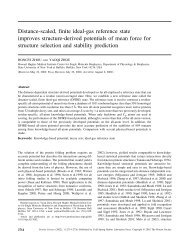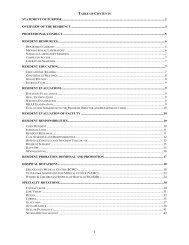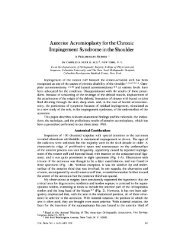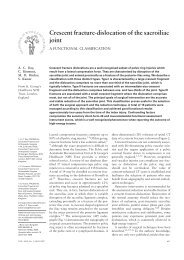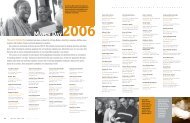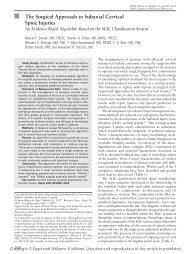Secondary Chondrosarcoma
Secondary Chondrosarcoma
Secondary Chondrosarcoma
You also want an ePaper? Increase the reach of your titles
YUMPU automatically turns print PDFs into web optimized ePapers that Google loves.
Patrick P. Lin, MD, et al<br />
Table 1<br />
Major Series on <strong>Secondary</strong> <strong>Chondrosarcoma</strong><br />
Study<br />
No. of<br />
Cases<br />
Preexisting<br />
Lesion (No.)<br />
Grade 14<br />
(No. of Cases)<br />
52 Solitary OC (21), HME (4),<br />
Coley and<br />
N/A<br />
Higinbotham 6 enchondroma (23), Ollier<br />
disease (4)<br />
Garrison et al 7 75 Solitary OC (40), HME (35) 1 (64), 2 (10), 3 (1)<br />
Hudson et al 8 15 Solitary OC (12), HME (3) 1 (11), 2 (3), 3 (1)<br />
Sun et al 12 5 Maffucci syndrome (all) 1 (1), 2 (3), N/A (1)<br />
Liuetal 9 12 Ollier disease (all) 1 (10), 2 (2)<br />
Merchan et al 10 4 HME (all) 1 (4)<br />
Wuisman<br />
45 Solitary OC (16), HME (29) 1 (30), 2 (13), 3 (2)<br />
et al 13<br />
Schaison<br />
29 Solitary OC (17), Ollier<br />
1(9),2(18),N/A(2)<br />
et al 11 disease (12)<br />
Ahmed et al 4 107 Solitary OC (61), HME (46) 1 (97), 2 (10)<br />
Altayetal 5 32 Solitary OC (14), HME (10), enchondroma<br />
(6), Ollier disease<br />
(1), Maffucci syndrome (1)<br />
1(28),2(4)<br />
HME = hereditary multiple exostosis, N/A = not available, OC = osteochondroma<br />
Table 2<br />
Risk Factors for <strong>Secondary</strong><br />
<strong>Chondrosarcoma</strong><br />
Clinical<br />
Pain<br />
Increasing size of a palpable lesion<br />
Male predominance (2:1)<br />
Location in the pelvis or hip<br />
Peak age in mid 30s<br />
Radiographic<br />
Surface irregularity<br />
Blurriness of the border<br />
Osteochondroma >5 cm<br />
Increase in size of osteochondroma<br />
Cartilage cap >2 cm<br />
Inhomogeneous mineralization of large<br />
cartilage cap<br />
Genetic<br />
Hereditary multiple exostosis (EXT1,<br />
EXT2, EXT3 mutations)<br />
Ollier disease<br />
Maffucci syndrome<br />
(5.5%) underwent dedifferentiation. 2<br />
Most cases of dedifferentiated chondrosarcomas<br />
appear to originate<br />
from central primary chondrosarcoma;<br />
it is estimated that the fraction<br />
of primary chondrosarcomas undergoing<br />
dedifferentiation may be as<br />
high as 15.4%. 3 In most cases, the<br />
prognosis of patients with dedifferentiated<br />
chondrosarcoma is dismal,<br />
which is quite unlike the prognosis<br />
of patients with secondary chondrosarcoma.<br />
<strong>Secondary</strong> chondrosarcoma is a<br />
well-recognized clinical diagnosis.<br />
However, relatively little has been<br />
published on the subject, perhaps as<br />
a result of the rarity of the condition.<br />
In a review of the literature, we<br />
found only 10 studies pertaining directly<br />
to the subject that were not<br />
case reports (Table 1).<br />
Clinical Presentation<br />
The most frequent presenting complaints<br />
with secondary chondrosarcoma<br />
are a palpable mass and pain.<br />
In many cases, the signs and symptoms<br />
are subtle, and the complaints<br />
are not severe. Large masses in the<br />
pelvis and thigh are easily hidden<br />
from patient and clinician alike. New<br />
onset of pain in a preexisting osteochondroma<br />
should alert the physician<br />
to the possibility of enlargement<br />
of the cartilaginous cap. Rarely,<br />
some tumors in the pelvis may cause<br />
urinary and bowel irregularities.<br />
A male predilection for secondary<br />
chondrosarcoma seems to be evident.<br />
Based on combined data from the<br />
published series, 63% of patients<br />
with the disease are male and 37%<br />
are female, resulting in a male:female<br />
ratio of approximately 2:1. 4-13 The<br />
mean age of persons with secondary<br />
chondrosarcoma is 34 years, which<br />
is notably younger than the average<br />
age of persons with primary conventional<br />
chondrosarcoma. 4-13 The most<br />
common site of involvement is the<br />
pelvis, followed by the proximal femur.<br />
The scapula and proximal humerus<br />
are also relatively common<br />
sites. Clinical, radiographic, and genetic<br />
features associated with secondary<br />
chondrosarcomas are summarized<br />
in Table 2.<br />
Our review of the major published<br />
series indicates that the great majority<br />
of cases arise in osteochondromas<br />
(88%), with solitary osteochondroma<br />
being slightly more common<br />
than multiple osteochondromas (ie,<br />
hereditary multiple exostosis). 4-7,11,13<br />
<strong>Secondary</strong> chondrosarcoma can also<br />
occur in persons with Ollier disease<br />
(ie, multiple enchondromas) and<br />
Maffucci syndrome (ie, multiple enchondromas<br />
associated with softtissue<br />
hemangiomas). Other benign<br />
cartilaginous lesions that have been<br />
reported, although rarely to result in<br />
secondary chondrosarcoma include<br />
solitary enchondroma, synovial<br />
chondromatosis, and chondromyxoid<br />
fibroma. 6,15-20 These lesions have<br />
been noted mostly in case reports,<br />
and there may be some question<br />
whether some cases were malignant<br />
at the outset. 6,15-20<br />
October 2010, Vol 18, No 10 609




